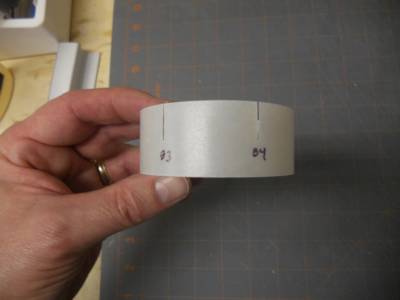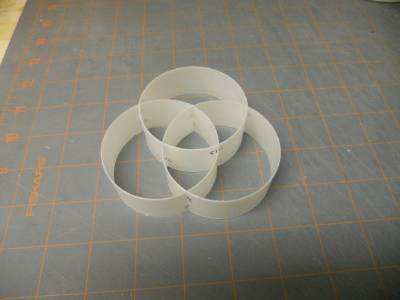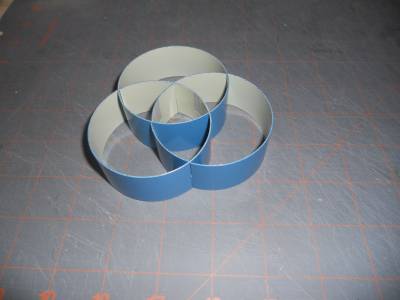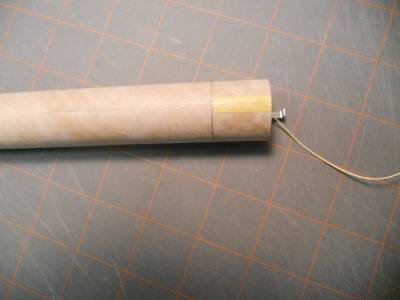| Construction Rating: | starstarstarstarstar_border |
| Flight Rating: | starstarstarstar_borderstar_border |
| Overall Rating: | starstarstarstarstar_border |
| Published: | 2014-09-25 |
| Diameter: | 0.98 inches |
| Length: | 12.25 inches |
| Manufacturer: | FlisKits  |
| Skill Level: | 2 |
 Brief
Brief
Celtic Thunder is a ring fin rocket that has a unique Celtic Knot fin ring design (an interlocking of three BT-80 rings). The finished rocket is 12.25" in length, has a balsa nosecone, is based on a BT-50 body tube (0.976" diameter), and has a fin span of 4.0'. It flies on 18-mm engines (the recommended engines are A8-3, B6-4, and C6-5), and equipped with a 48" crepe streamer. The original design was by Ray DiPaola from CMASS (NAR Section #464) and CATO (NAR Section #581). FlisKits offered the Celtic Thunder as the Fliskits' 10th Anniversary Commemorative kit in 2012.
Components
There are only 17 individual parts in this kit, but it is more than your typical 3FNC. A complete list of parts is as follows:
- Hardware Pack:
- 1 Engine block, 18mm
- 2 Centering rings, BT20/BT50
- 1 Kevlar shock line, 18"
- 1 Shroud line, 12"
- 1 Screw eye
- 1 C-size engine hook
- 1 Launch lug, 1" x 1/8"
- 1 Streamer, crepe, 48"
- 1 Tape disk
- Loose parts:
- 1 Nose cone, Balsa
- 3 Body tubes, 1" long (BT-80)
- 1 Body tube, 9" long (BT-50)
- 1 Elastic shock cord, 18"
- 1 Decal sheet
- 1 Tube marking guide
- 1 Instruction sheet
The components were all of high quality. The BT-80 ring fins were not cardboard, but a spiral-wound material like mylar that is very stiff and stable. I'd love to buy body tubes from this material.
Construction
The kit requires you to supply wood glue, white glue, pencil, scissors and the standard hobby knife, ruler, and masking tape needed by all rockets. To finish the rocket you will also need balsa fillercoat, sanding sealer, a good sandable primer, sandpaper, and masking tape.
The instruction manual typical of Jim Flis' products, complete with clear illustrations to guide you through the build. The instructions are logically ordered, and Jim guides you through the seemingly tricky assembly of the celtic knot fins, making it easy enough to make you wonder why you thought this was going to be hard.

Figure 1 - Motor Mount Assembly
The 18mm motor mount went together quickly with wood glue and tape, resulting in a subassembly with the Kevlar cord, engine hook, and engine block attached. The two centering rings adapt the BT20 motor mount tube to the BT50 airframe (see figure 1). I let the glue on this assembly dry while I cut the slots on the three BT80 body tubes that will become the interlocked tube fins. The instructions here are very good, but you need a sharp hobby knife to cut through the tough rings. I cut the slots with sharp scissors as described, using the wrap-around templates (figure 2), resulting in tube-fins that looked just like the illustrations in the instructions (figures 3 and 4).

Figure 2 - Ring Marking Guides

Figure 3 - Marked Ring

Figure 4 - Assembled Ring Fin Assembly
As the instructions point out, if you want to use multiple colors on the fins, you need to finish prepping and painting the fins at this point of the build, which is what I did. After filling in the spirals with Elmer's Fill n Finish and sanding, I masked off a small section on each tube that would later be located at center of the celtic know and be in contact with the outside of the body tube. I left this tape on while priming the fins inside and out, and then painted the inside of the tubes, followed by painting the outside in a contrasting color after masking the inside of the tubes. After the paint was dry, I dry-assembled the painted fins to ensure that all the unmasked glue areas were properly oriented. I then glued the fins together using medium CA, although white glue would have worked as well (figure 5).

Figure 5 - Painted Fin Ring Assembly
After filling the body tube spirals and sanding smooth, I installed the motor mount per the instructions, recessing the assembly so the end of the motor mount was flush with the end of the body tube. I also attached the launch lug at this point: after marking lines for the fin attachment points and the launch lug on the body tube (the launch lug line was in line with the engine hook), I dry assembled the body tube with the fin assembly, aligning the launch lug line with one of the voids in the fin unit. The end of the engine hook is flush with the rear edge of the fin unit. Once aligned, I marked the location of the launch lug on the body tube and the locations where the top of the fin unit intersected the fin lines, removed the body tube from the fin unit, and glued the launch lug at the marked location. After the glue dried I then masked the areas of the body tube that would contact the fin unit in final assembly (figure 6).

Figure 6 - Body Tube Masked for Painting
After priming and sanding, I spray-painted the body tube and removed the masking tape once the paint had dried. I glued the fin unit to the body tube using the trick suggested by the instructions: "Slide the Fin Unit onto the Body Tube such that the glue lines are centered down CORNERS of the inside of the unit (such that the glue does not touch the fin unit). Once you have it properly positioned, you can simply twist the unit into the glue, until the Engine Hook is properly centered in a corner of the Fin Unit." That trick worked very well, spreading the glue and not making a big mess of it. Aligning the body tube perpendicular to the fin unit is harder than it would seem to be because the body tube did not fit particularly tightly in the fin unit, and is supported solely by the engine hook, allowing the body tube to tip. I solved this problem by installing a used engine casing attached to a dowel that was built up with tape to lightly fit in the 3/4" bench-dog hole in my workbench. Thus, I made a jig that maintained the alignment as the glue dried (figure 7).

Figure 7 - Assembly "Jig"
To finish the nosecone, I simply filled the balsa, sanded, sealed with a few coats of balsa sanding sealer, sanding lightly between coats, and finally primed, sanded, and spray-painted the final color. The screw eye was glued into the nosecone, and the elastic shock cord attached to the Kevlar cord and to the screw eye. The streamer was assembled per the instructions and tied to the screw eye. The The high-qualtiy, water-slide decals were applied at the locations shown on the kit cover art. The completed rocket (figure 8) weighed in at 33.9 g (1.2 oz).
Flight
I flew the Celtic Thunder March 4, 2014 (May the Fourth be with you!) on an Estes A8-3 motor (recommended first flight motor). This was a good choice for the first flight, during which the rocket boosted well, did not rotate, and was readily visible for the whole flight. The motor ejection delay was just about perfect, and the model landed close to the pad. The entire ring fin assembly detached from the body tube upon landing, but it will be easily repaired. The streamer worked well enough, as the velocity did not seem too fast.
Recovery
The ring fin detachment was a cause for concern as there is very little contact area for the glue joints, and the ring fin material is very glossy. Even scuffing up the surface, as I did, did not allow strong enough glue joints.
Summary
I really liked the build and the challenge of the painting. The only disappointment for the first flight was the fin assembly detachment upon a relatively soft landing. The rocket flew arrow straight, and with the inclusion of a small parachute, the ring fin issue will likely be solved.
 |
 |
Flights
 |
 |